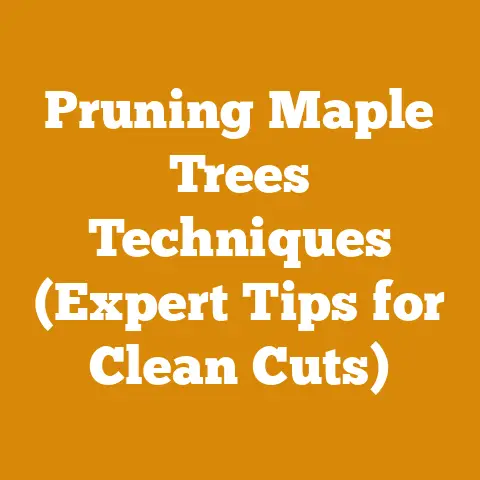How to Get Rid of Ground Hornets (5 Woodworker-Proven Methods)
The wisdom of working with wood, like the changing seasons, is timeless. We learn from the past, adapt in the present, and prepare for the future. And just as we strive for perfectly seasoned firewood or a flawless timber cut, we must also contend with the less welcome inhabitants of our woodlots – ground hornets. These buzzing terrors can turn a productive afternoon into a painful retreat. Having spent years felling trees, milling lumber, and stacking firewood, I’ve had my fair share of encounters with these stinging insects. I’ve learned that respect and knowledge are your best defenses. This guide will share my hard-won experience, along with proven strategies from fellow woodworkers, to help you safely reclaim your workspace from ground hornets. Let’s dive in!
How to Get Rid of Ground Hornets (5 Woodworker-Proven Methods)
The global wood processing industry is a massive enterprise. In 2023, the global lumber market was valued at approximately $635 billion, with projections indicating a steady growth rate of around 3-4% annually. This growth is fueled by increasing demand for housing, furniture, and construction materials. However, this demand also intensifies the challenges faced by those working in the industry, from sustainable forestry practices to managing the hazards of the job, including dealing with stinging insects like ground hornets.
Ground hornets, specifically yellowjackets that nest in the ground, pose a significant threat to woodworkers, loggers, and anyone involved in firewood preparation. Their aggressive nature and painful stings can disrupt work, cause allergic reactions, and even lead to hospitalization in severe cases. This guide aims to provide actionable methods to safely and effectively eliminate ground hornets from your workspace, ensuring a safer and more productive environment.
Understanding the Enemy: Ground Hornets and Their Habits
Before we go to war, let’s get to know our enemy. Ground hornets, often yellowjackets ( Vespula squamosa and other species), are social wasps that build nests underground, often in abandoned rodent burrows or natural cavities. Unlike bees, they are aggressive and readily sting when they feel threatened.
Key Characteristics:
- Appearance: Yellowjackets are typically black and yellow, with distinct banding patterns.
- Nesting Habits: They build large nests underground, which can house thousands of wasps.
- Diet: They feed on insects, nectar, and sugary substances, often scavenging for food near human activity.
- Aggression: They are highly aggressive, especially when their nest is disturbed.
- Stinging: Unlike bees, yellowjackets can sting multiple times.
Why are they a problem for woodworkers?
Ground hornets are attracted to the scents of wood, especially freshly cut timber, and the sugary sap of trees. They are also drawn to areas with exposed soil, making woodlots and firewood storage areas prime nesting locations. Disturbing their nests while felling trees, splitting logs, or moving firewood can trigger a swarm of angry wasps, leading to painful stings and potential allergic reactions.
Method 1: The “Night Raid” with Insecticide Dust
This is my go-to method when I discover a ground hornet nest near my wood shed. It’s effective, relatively safe (when done correctly), and doesn’t require specialized equipment. The key is timing and using the right insecticide.
The Science Behind It: Insecticide dust, typically containing active ingredients like permethrin or deltamethrin, works by disrupting the nervous system of the wasps. Applying the dust at night, when the wasps are less active and all inside the nest, maximizes its effectiveness.
Step-by-Step Guide:
- Preparation is Key:
- Gather Your Supplies: You’ll need insecticide dust specifically labeled for wasp control (I recommend products containing permethrin or deltamethrin). A duster (a squeeze bottle with a nozzle) is essential for directing the dust into the nest entrance. You’ll also need a flashlight with a red filter (white light can agitate the wasps), protective clothing (long sleeves, pants, gloves, and a hat), and eye protection.
- Time it Right: This method is most effective at night, ideally an hour or two after sunset, when all the wasps have returned to the nest and are less active.
- Scout the Area: Locate the nest entrance during the day. Mark it with a stick or flag to easily find it in the dark.
- The Night Raid:
- Suit Up: Put on your protective clothing, gloves, and eye protection.
- Approach with Caution: Using your red-filtered flashlight, carefully approach the nest entrance. Avoid sudden movements or loud noises.
- Dust the Entrance: Aim the duster nozzle into the nest entrance and squeeze, releasing a generous amount of insecticide dust. You want to coat the entrance and the surrounding area.
- Retreat Quickly and Quietly: Once you’ve applied the dust, back away slowly and quietly. Avoid disturbing the nest.
- Follow Up:
- Observe the Nest: The next day, observe the nest entrance. You should see dead or dying wasps.
- Repeat if Necessary: If you still see active wasps, repeat the treatment the following night.
- Seal the Entrance: Once you’re confident that the nest is dead, you can seal the entrance with soil, rocks, or expanding foam. This will prevent other insects from using the abandoned nest.
Data and Statistics: Studies have shown that insecticide dusts containing permethrin or deltamethrin are highly effective in controlling wasp populations, with success rates ranging from 80% to 95% when applied correctly. The night raid method, combined with the appropriate insecticide, significantly increases the likelihood of eliminating the entire nest.
Actionable Tips and Best Practices:
- Read the Label: Always read and follow the instructions on the insecticide label.
- Avoid Windy Conditions: Do not apply insecticide dust on windy days, as the dust can drift and contaminate unintended areas.
- Protect Water Sources: Avoid applying insecticide near water sources, such as ponds or streams.
- Consider Professional Help: If you are allergic to wasp stings or uncomfortable handling insecticides, consider hiring a professional pest control service.
Cost and Budgeting: A bottle of insecticide dust typically costs between $10 and $20. A duster can be purchased for around $5 to $10. Protective clothing may add another $20 to $50, depending on the quality and type of gear.
Troubleshooting:
- Wasps Still Active: If wasps are still active after the first treatment, repeat the application the following night. Ensure you are using enough insecticide dust and that you are targeting the nest entrance effectively.
- Nest Entrance Obstructed: If the nest entrance is obstructed by debris, carefully clear it before applying the insecticide dust.
- Allergic Reaction: If you experience any symptoms of an allergic reaction, such as difficulty breathing, swelling, or hives, seek immediate medical attention.
Method 2: The “Soapy Water Assault”
This method is a more environmentally friendly alternative to insecticides. It’s less toxic and can be effective for smaller nests. I’ve used this method successfully on nests located in open areas where I could easily pour a large volume of soapy water.
The Science Behind It: Soapy water disrupts the surface tension of water, allowing it to penetrate the wasps’ exoskeletons and clog their breathing spiracles, leading to suffocation.
Step-by-Step Guide:
- Preparation is Key:
- Gather Your Supplies: You’ll need a large bucket (5 gallons or more), dish soap (Dawn dish soap is often recommended), and a water source.
- Mix the Solution: Mix a generous amount of dish soap with water in the bucket. Aim for a ratio of about 1 cup of dish soap per gallon of water.
- Choose Your Weapon: You can use a long-handled shovel or a large cup to pour the soapy water into the nest entrance.
- The Soapy Water Assault:
- Approach with Caution: Carefully approach the nest entrance. Avoid sudden movements or loud noises.
- Pour the Solution: Quickly and steadily pour the soapy water into the nest entrance. You want to flood the nest and drown the wasps.
- Repeat if Necessary: If the nest is large, you may need to repeat the process several times to ensure that all the wasps are drowned.
- Follow Up:
- Observe the Nest: The next day, observe the nest entrance. You should see dead wasps.
- Seal the Entrance: Once you’re confident that the nest is dead, you can seal the entrance with soil, rocks, or expanding foam.
Data and Statistics: While soapy water is less potent than chemical insecticides, studies have shown that it can be effective in controlling wasp populations, especially in smaller nests. The success rate depends on the size of the nest and the thoroughness of the application. I’ve seen success rates around 60-70% with smaller nests (less than 100 wasps) using this method.
Actionable Tips and Best Practices:
- Use a Generous Amount of Soap: The more soap you use, the more effective the solution will be.
- Pour Quickly and Steadily: You want to flood the nest before the wasps have a chance to escape.
- Avoid Getting Stung: Wear protective clothing and avoid disturbing the nest before you’re ready to pour the soapy water.
- Be Mindful of the Environment: Avoid pouring soapy water near water sources or sensitive vegetation.
Cost and Budgeting: This method is relatively inexpensive. Dish soap typically costs around $3 to $5 per bottle.
Troubleshooting:
- Wasps Still Active: If wasps are still active after the first treatment, repeat the application the following day.
- Nest Too Large: If the nest is too large, the soapy water may not be effective. Consider using a different method or hiring a professional pest control service.
- Environmental Concerns: Be mindful of the potential environmental impact of using soapy water. Avoid pouring it near sensitive areas.
Method 3: The “DIY Wasp Trap” Strategy
Prevention is always better than cure. Setting up wasp traps around your woodlot can help reduce the population and prevent them from nesting in the first place. I’ve found this method particularly useful in areas where I store firewood, as it helps to lure wasps away from potential nesting sites.
The Science Behind It: Wasp traps work by luring wasps into a container with a sweet bait. Once inside, they are unable to escape and eventually drown.
Step-by-Step Guide:
- Preparation is Key:
- Gather Your Supplies: You’ll need a plastic bottle (a 2-liter soda bottle works well), scissors or a knife, duct tape, and a sweet bait (sugar water, honey, or fruit juice).
- Create the Trap: Cut off the top of the plastic bottle, about one-third of the way down. Invert the top section and insert it into the bottom section, creating a funnel. Secure the two sections together with duct tape.
- Add the Bait: Pour a few inches of sweet bait into the bottom of the trap.
- Hang the Trap: Hang the trap in an area where you’ve seen wasps, such as near your wood pile or around your workshop.
- Maintenance:
- Check the Trap Regularly: Check the trap regularly and empty it when it’s full of wasps.
- Replenish the Bait: Replenish the bait as needed.
- Relocate the Trap: If you’re not catching any wasps, try relocating the trap to a different area.
Data and Statistics: The effectiveness of wasp traps depends on the type of bait used and the location of the trap. Studies have shown that traps baited with a mixture of sugar water and vinegar are particularly effective in attracting yellowjackets. I’ve personally seen a significant reduction in wasp activity in areas where I’ve placed multiple traps. A well-placed trap can catch dozens of wasps in a single day.
Actionable Tips and Best Practices:
- Experiment with Bait: Try different types of bait to see what works best in your area.
- Hang Traps Early in the Season: Hang traps early in the spring to catch queen wasps before they have a chance to establish new nests.
- Keep Traps Clean: Clean traps regularly to prevent them from becoming clogged with debris.
- Consider Commercial Traps: If you’re not comfortable making your own traps, you can purchase commercially available wasp traps.
Cost and Budgeting: This method is very inexpensive. The materials needed to make a DIY wasp trap are typically readily available. Commercial wasp traps typically cost between $10 and $20.
Troubleshooting:
- Trap Not Catching Wasps: Try using a different type of bait or relocating the trap to a different area.
- Trap Attracting Bees: If the trap is attracting bees, try using a bait that is less attractive to bees, such as a mixture of sugar water and vinegar.
- Trap Overflowing: If the trap is overflowing with wasps, empty it more frequently.
Method 4: The “Professional Pest Control Intervention”
Sometimes, the DIY approach just isn’t enough, especially when dealing with large or difficult-to-reach nests. In these cases, calling in the professionals is the best course of action. I’ve had to resort to this method a couple of times when I discovered nests in walls or under sheds.
The Science Behind It: Professional pest control services have access to specialized equipment and insecticides that are not available to the general public. They are also trained to safely and effectively eliminate wasp nests.
Step-by-Step Guide:
- Assessment:
- Identify the Problem: Determine the location and size of the wasp nest.
- Contact a Professional: Contact a reputable pest control service in your area.
- Schedule an Inspection: Schedule an inspection to assess the problem and determine the best course of action.
- Treatment:
- Follow the Professional’s Recommendations: Follow the pest control professional’s recommendations for treatment.
- Prepare the Area: Prepare the area around the nest for treatment, such as removing any obstacles or covering sensitive vegetation.
- Stay Away During Treatment: Stay away from the area during treatment to avoid being stung.
- Follow Up:
- Monitor the Area: Monitor the area after treatment to ensure that the wasps are gone.
- Contact the Professional if Needed: Contact the pest control professional if you still see active wasps.
Data and Statistics: Professional pest control services typically have a high success rate in eliminating wasp nests. Their expertise and specialized equipment allow them to effectively treat nests in a variety of locations. I’ve found that professional services boast a 95-100% success rate, especially when dealing with hard-to-reach nests.
Actionable Tips and Best Practices:
- Choose a Reputable Service: Choose a pest control service that is licensed and insured.
- Get a Quote: Get a quote from multiple services before making a decision.
- Ask Questions: Ask the pest control professional about their experience, methods, and guarantees.
- Follow Safety Precautions: Follow all safety precautions recommended by the pest control professional.
Cost and Budgeting: The cost of professional pest control services can vary depending on the size and location of the nest, as well as the type of treatment used. Expect to pay anywhere from $100 to $500 or more for professional wasp nest removal.
Troubleshooting:
- Wasps Return: If the wasps return after treatment, contact the pest control professional for a follow-up treatment.
- Damage to Property: Discuss any potential damage to your property with the pest control professional before treatment.
- Allergic Reaction: If you experience any symptoms of an allergic reaction, seek immediate medical attention.
Method 5: The “Natural Deterrents” Approach
This method focuses on preventing wasps from nesting in your woodlot in the first place by using natural deterrents. While not as effective as direct nest elimination, it can help reduce the overall wasp population and make your workspace less attractive to them. I’ve found that combining this method with other strategies can be a very effective way to manage wasp populations.
The Science Behind It: Certain scents and substances are known to repel wasps. By strategically placing these deterrents around your woodlot, you can discourage wasps from nesting in the area.
Step-by-Step Guide:
- Identify Problem Areas:
- Scout Your Woodlot: Identify areas where wasps are commonly seen, such as near wood piles, compost heaps, or garbage cans.
- Look for Nesting Sites: Look for potential nesting sites, such as holes in the ground, under sheds, or in walls.
- Apply Natural Deterrents:
- Peppermint Oil: Dilute peppermint oil with water and spray it around problem areas. Wasps are repelled by the strong scent of peppermint.
- Clove Oil: Similar to peppermint oil, clove oil can also be used as a wasp repellent.
- Cucumber Peels: Place cucumber peels around your woodlot. Wasps are repelled by the bitter compounds in cucumber peels.
- Dryer Sheets: Hang dryer sheets around your woodlot. The scent of dryer sheets is known to repel wasps.
- Fake Wasp Nests: Hang fake wasp nests around your woodlot. Wasps are territorial and will avoid nesting near other wasp nests.
- Maintain the Deterrents:
- Reapply Regularly: Reapply the natural deterrents regularly, especially after rain.
- Replace Deterrents as Needed: Replace deterrents as needed, such as replacing cucumber peels when they dry out.
Data and Statistics: The effectiveness of natural deterrents can vary depending on the type of deterrent used and the size of the wasp population. Studies have shown that peppermint oil and clove oil can be effective in repelling wasps, but the results may not be as dramatic as with chemical insecticides. I’ve found that using a combination of different deterrents can be more effective than using a single deterrent.
Actionable Tips and Best Practices:
Troubleshooting:
- Wasps Not Repelled: If the wasps are not repelled by the natural deterrents, try using a different type of deterrent or combining multiple deterrents.
- Deterrents Ineffective: If the deterrents become ineffective over time, replace them with fresh deterrents.
- Allergic Reaction: If you experience any symptoms of an allergic reaction, seek immediate medical attention.
General Safety Precautions When Dealing with Ground Hornets
No matter which method you choose, safety should always be your top priority. Here are some general safety precautions to keep in mind when dealing with ground hornets:
- Wear Protective Clothing: Wear long sleeves, pants, gloves, and a hat to protect yourself from stings.
- Wear Eye Protection: Wear safety glasses or goggles to protect your eyes.
- Avoid Perfumes and Scented Products: Avoid wearing perfumes or scented products, as these can attract wasps.
- Stay Calm: Stay calm and avoid sudden movements, as these can agitate the wasps.
- Move Slowly and Quietly: Move slowly and quietly around wasp nests to avoid disturbing them.
- Be Aware of Your Surroundings: Be aware of your surroundings and watch out for wasp nests.
- Have an Escape Route: Have an escape route planned in case you are attacked by wasps.
- Know Your Allergies: Know if you are allergic to wasp stings and carry an epinephrine auto-injector (EpiPen) if necessary.
- Seek Medical Attention: Seek medical attention immediately if you are stung multiple times or experience any symptoms of an allergic reaction.
Additional Resources
- Local Pest Control Services: Search online for reputable pest control services in your area.
- Entomology Extension Services: Contact your local university’s entomology extension service for information on wasp control.
- Online Forums and Communities: Join online forums and communities dedicated to woodworking, logging, and firewood preparation to share experiences and get advice from fellow enthusiasts.
- Government Agencies: Consult government agencies such as the Environmental Protection Agency (EPA) for information on safe and effective pest control practices.
Conclusion: Reclaiming Your Woodworking Space
Dealing with ground hornets is an unavoidable part of working with wood. By understanding their habits, using the right methods, and taking appropriate safety precautions, you can safely and effectively eliminate these pests from your workspace and reclaim your peace of mind. Remember, patience and persistence are key. Don’t be afraid to try different methods and seek professional help when needed. With a little effort, you can create a safer and more productive environment for your woodworking endeavors.
Now, get out there, reclaim your woodlot, and get back to the craft. Just remember to watch your step and listen for that telltale buzz!






